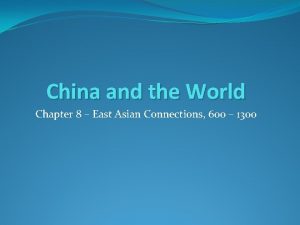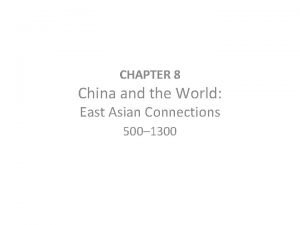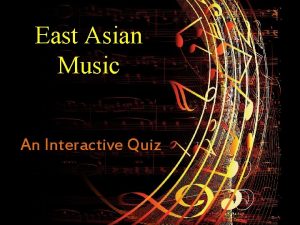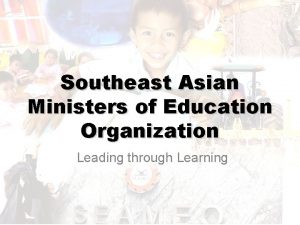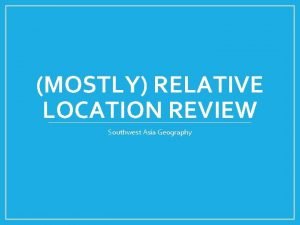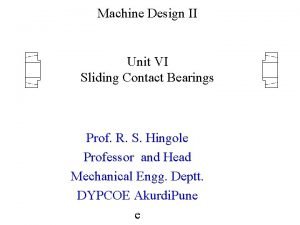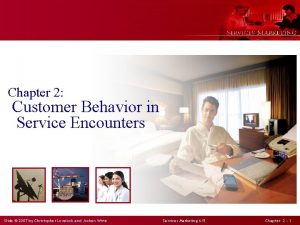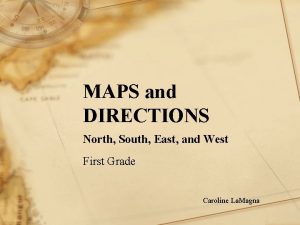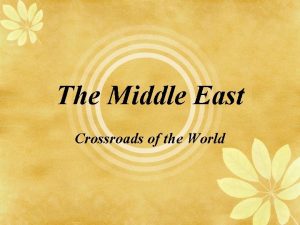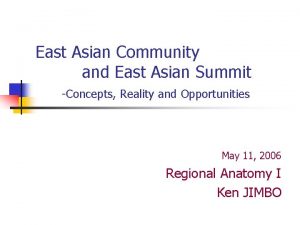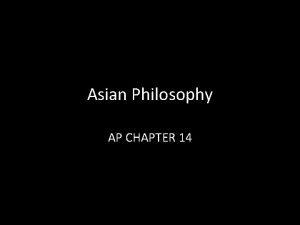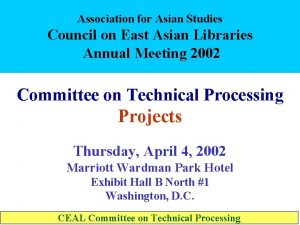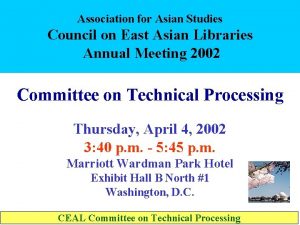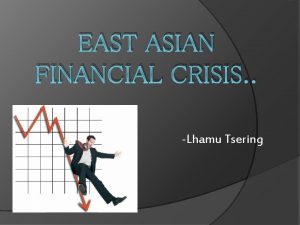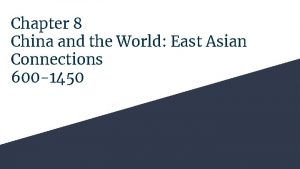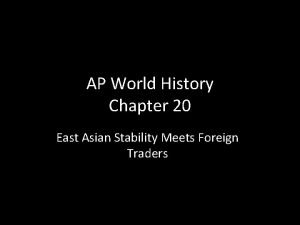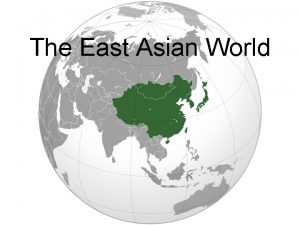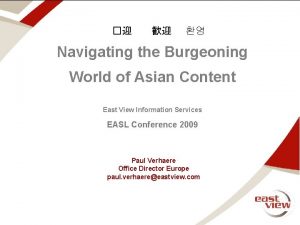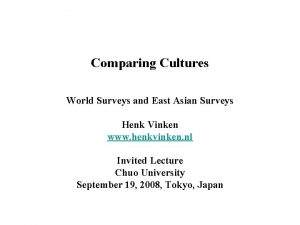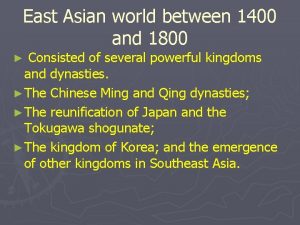Chapter 17 The East Asian World Contact with






















- Slides: 22

Chapter 17 The East Asian World

Contact with the West • Increased contact with the west • China and Japan attempted to resist encroachment using different means and with differing levels of success

Ming Dynasty • By 1368, the Ming Dynasty booted out the last Mongol rulers in China and restored power over the empire to the native Chinese. • The Ming Dynasty ruled until 1644 and reestablished the following: – a strong centralized government based on traditional Confucian principals – reinstated the civil service examination, – removed the Mongol influence by reinvigorating Chinese culture.

Ming Interactions • Emperor Yongle sponsors voyages in the early 1400’s – The voyages led by Zeng He, a Chinese navigator sailed throughout S. E Asia and the Indian Ocean, all the way to East Africa, a century before the Europeans did the same.

Ming Interactions – The Chinese abruptly stopped their naval voyages due to the cost. – After Emperor Yongle’s death Chinese increasingly, turned inward. • By 16 th century, Chinese trading with the Portuguese, Spanish, and Dutch.

The Ming Dynasty and Silver • The Ming government attempted to prop up the failing economy by changing easily counterfeited paper money to a “single-whip” system based on silver currency. • Initially, the silver came from Japan, but with the discovery of American silver sources. • China establishes trade relations with the Spanish through the Philippines

Silver • This exchange fueled a period of commercial expansion. • The silver flooded the Chinese market and the government was unable to control the resulting inflation.

Problems Persisted • Many factors contributed to the Ming Dynasty's decline: – By the sixteenth century the Ming dynasty was already in decline. – Pirates increasingly raided port cities. – The Chinese were able to keep the Europeans at a safe distance.

Problems Persisted – However internal problems persisted. • Weak rulers • Crop Failures • Inflation led to unrest

Qing (Manchu) Dynasty • By the seventeenth century, famines crippled the Chinese economy, and peasant revolts erupted against increasingly powerless Ming rulers. • In 1644, the Ming emperor invited a group of Qing warriors from nearby Manchuria to help him with peasant uprising. • The Qing ousted the emperor. With that act, the Ming Dynasty ended. • The Qing (Manchu) Dynasty began. The Manchus ruled China until about 1912.

Changes in China • The Qing made many changes in China. – Forbid the Chinese to learn the Manchu language or marry Manchus (3% of population) – civil service gained new heights – Banned Christianity in 1724 – Impose Manchu dress and customs on Chinese

Qing Rulers • Two long-ruling emperors, Kangxi (16611722) and Qianlong (1736 -1795) allow for stability and acceptance. • Both of these emperors supported the arts but also expanded the empire – Kangxi ruled from 1662 -1722 was a Confucian scholar, and conquered Taiwan and Tibet – Qianlong ruled from 1735 -1795 and added Vietnam, Burma, Nepal as vassal states to China

Qing and Commerce • In 1757, restricted Europeans to trading in the port city of Canton. – Europeans bought large quantities of tea, silk, and porcelain – In exchange the merchants received huge sums of silver, which created a new rising class of merchants in the coastal cities – British pressure for more balanced trade (pottery & tea) – China remained agrarian, with trade and industry controlled by state – Maintained negative attitude toward industry, unequal taxes

Qing and. Society • • Continued focus on family Arranged marriages, male dominated Women not educated, in charge of the home Practice of female infanticide

Japan and the Shogunate • Warring states period in late 1400’s, after decline of Ashikaga Shogunate • Oda Nobunaga, Toyotomi Hideyoshi, and Tokugawa Ieyasu helped unify Japan • Tokugawa, the daimyo of Edo, names himself Shogun in 1603.

Tokugawa Shogunate • In 1600, Tokugawa Ieysau established the Tokugawa Shogunate, a strict and rigid government that ruled Japan until 1868 • Emperor is largely a figurehead. • Power was given to the daimyo (feudal lords) • Ieysau took ownership of all the land instituted a rigid social class model. – More like a caste system – Four classes (warrior, farmer, artisan, and merchant) were established and movement in classes was forbidden.

Japan and Christianity • In 1542, the Portuguese established trade with the empire (they also introduced guns to the Japanese). • Within a decade, Christian missionaries streamed in. • By the end of the century, a few hundred thousands Japanese converted to Christianity • Missionaries destroyed Shinto shrines.

Japan and Christianity • The Jesuits took control of the port city Nagasaki and trade flourished. • Christians were persecuted • Hideyoshi expels missionaries in 1587, but allows merchants to stay. • Tokugawa finalized expulsion in 1602. • Merchants evicted as well, except Dutch, who were given limited rights

Edo Period • Shogun moved capital to Edo (modern day Tokyo) • In 1635, National Seclusion Policy prohibited Japanese from… – traveling abroad – prohibited foreigners from visiting Japan (kept relations with China, Korea, Netherlands) – lasted for 200 years – This was passed to curb foreign influence

Daimyo • Daimyo were forced to maintain two residences to allow for control • Strain on finances led many to take back fiefs from samurai and make them into salaried workers • Samurai role as warriors declines • Revolts by ronin (masterless samurai) or peasants • Large population increase

Japanese Economy • New technology and exposure led to industrial & commercial revolutions • Development of paper money

Japanese Culture • Buddhism and Shinto remained at the center of culture • Kabuki theater and haiku poetry became popular
 Chapter 8 china and the world east asian connections
Chapter 8 china and the world east asian connections Chapter 8 china and the world east asian connections
Chapter 8 china and the world east asian connections Statements about changgo
Statements about changgo Southeast asian ministers of education
Southeast asian ministers of education Relative location of israel
Relative location of israel Which force
Which force Advantages and disadvantages of sliding contact bearing
Advantages and disadvantages of sliding contact bearing Non contact force definition
Non contact force definition Contact and noncontact forces
Contact and noncontact forces Dermatitis atopica icd 10
Dermatitis atopica icd 10 Air resistance non contact force
Air resistance non contact force Dangling bond
Dangling bond Post encounter stage in service marketing
Post encounter stage in service marketing What are some contact forces and some noncontact forces?
What are some contact forces and some noncontact forces? Contact and non contact forces
Contact and non contact forces Asian american inventors
Asian american inventors What is the horizontal movement of air called
What is the horizontal movement of air called Laissez faire theory
Laissez faire theory East is east and west is west
East is east and west is west Maps.google.comps
Maps.google.comps Crossroads of the world middle east
Crossroads of the world middle east Ap world history chapter 25 africa and the atlantic world
Ap world history chapter 25 africa and the atlantic world Hình ảnh bộ gõ cơ thể búng tay
Hình ảnh bộ gõ cơ thể búng tay
